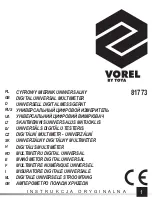
DVM903
V. 02
–
29/01/2020
15
©Velleman nv
10.6
FREQUENCY AND DUTY CYCLE MEASUREMENT
Do not conduct frequency or continuity measurements on live
circuits. Make sure all capacitors in the circuit are depleted.
1.
Set the rotary switch in the “Hz” position.
2.
Connect the red test lead to the
“V
Hz”
jack and the black one to the
“COM” jack.
3.
Press “Hz/%” to choose the frequency or duty cycle measurement.
4.
Connect the test leads to the source to be measured and read the LCD
display.
10.7
TEMPERATURE MEASUREMENT
1.
Connect the red banana plug to the
“V
Hz”
jack and the black one to
“COM”.
2.
Set the rotary switch in the
“
°C
/°F”
position.
3.
Press SELECT to choose the °C or °F measurement.
4.
Put the probe into the field to be measured and read the LCD display.
10.8
BATTERY TEST
1.
Connect the red test lead to
the “
µA
mA”
jack and the black one to
“COM”.
2.
Set the rotary switch to the
“1.5V”, “9V” or “12V” position.
3.
Put the probe into the field to be measured and read the LCD display.
10.9
NCV DETECTION
1.
Set the rotary switch to the “NCV” pos
ition.
2.
Hold the appliance so that its top is vertically and horizontally centered
and contacting the conductor. When live voltage ≥
90 V AC rms, the
built-in buzzer will sound.
NOTES
1.
Even without buzzer sounds, voltage may still exist. Do not rely solely
on non-contact voltage detection to determine the presence of voltage.
Detection operation may be subject to socket design, insulation
thickness and different type and other factors.
2.
When the meter input terminals detect voltage, due to the influence of
present voltage, the voltage sensing indicator may also light.
3.
Keep the appliance away from electrical noise sources during tests, i.e.
fluorescent and dimmable lights, motors, etc. These sources may
trigger NCV detection and invalidate the test.
















































